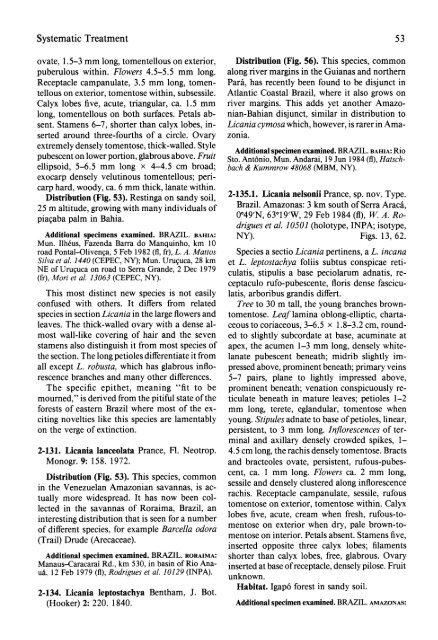flora neotropica - CNCFlora
flora neotropica - CNCFlora
flora neotropica - CNCFlora
You also want an ePaper? Increase the reach of your titles
YUMPU automatically turns print PDFs into web optimized ePapers that Google loves.
Systematic Treatment 53<br />
ovate, 1.5-3 mm long, tomentellous on exterior, Distribution (Fig. 56). This species, common<br />
puberulous within. Flowers 4.5-5.5 mm long. along river margins in the Guianas and northern<br />
Receptacle campanulate, 3.5 mm long, tomen- Para, has recently been found to be disjunct in<br />
tellous on exterior, tomentose within, subsessile. Atlantic Coastal Brazil, where it also grows on<br />
Calyx lobes five, acute, triangular, ca. 1.5 mm river margins. This adds yet another Amazolong,<br />
tomentellous on both surfaces. Petals ab- nian-Bahian disjunct, similar in distribution to<br />
sent. Stamens 6-7, shorter than calyx lobes, in- Licania cymosa which, however, is rarer in Amaserted<br />
around three-fourths of a circle. Ovary zonia.<br />
extremely densely tomentose, thick-walled. Style Additional<br />
pubescent on lower portion, glabrous above. Fruit<br />
specimen examined. BRAZIL. BAHIA: Rio<br />
Sto. Antonio, Mun. Andarai, 19 Jun 1984 (fl), Hatschellipsoid,<br />
5-6.5 mm long x 4-4.5 cm broad; bach & Kummrow 48068 (MBM, NY).<br />
exocarp densely velutinous tomentellous; pericarp<br />
hard, woody, ca. 6 mm thick, lanate within.<br />
Distribution (Fig. 53). Restinga on 2-135.1. Licania nelsonii<br />
sandy soil,<br />
Prance, sp. nov. Type.<br />
25 m altitude, growing with many individuals of Brazil. Amazonas: 3 km south of Serra Araca,<br />
piaCaba palm in Bahia.<br />
0?49'N, 63?19'W, 29 Feb 1984 (fl), W. A. Rodrigues<br />
et al. 10501 (holotype, INPA; isotype,<br />
Additional specimens examined. BRAZIL. BAHIA: NY). Figs. 13, 62.<br />
Mun. Ilheus, Fazenda Barra do Manquinho, km 10<br />
road Pontal-Olivenca, 5 Feb 1982 (fl, fr), L. A. Mattos Species a sectio Licania pertinens, a L. incana<br />
Silva et al. 1440 (CEPEC, NY); Mun. Uruguca, 28 km et L. leptostachya foliis subtus conspicae reti-<br />
NE of Urucuca on road to Serra Grande, 2 Dec 1979<br />
(fr), Mori et al. 13063 culatis, stipulis a base peciolarum adnatis, re-<br />
(CEPEC, NY).<br />
ceptaculo rufo-pubescente, floris dense fascicu-<br />
This most distinct new species is not easily latis, arboribus grandis differt.<br />
confused with others. It differs from related Tree to 30 m tall, the young branches brownspecies<br />
in section Licania in the large flowers and tomentose. Leaf lamina oblong-elliptic, chartaleaves.<br />
The thick-walled ovary with a dense al- ceous to coriaceous, 3-6.5 x 1.8-3.2 cm, roundmost<br />
wall-like covering of hair and the seven ed to slightly subcordate at base, acuminate at<br />
stamens also distinguish it from most species of apex, the acumen 1-3 mm long, densely whitethe<br />
section. The long petioles differentiate it from lanate pubescent beneath; midrib slightly imall<br />
except L. robusta, which has glabrous inflo- pressed above, prominent beneath; primary veins<br />
rescence branches and many other differences. 5-7 pairs, plane to lightly impressed above,<br />
The specific epithet, meaning "fit to be prominent beneath; venation conspicuously remourned,"<br />
is derived from the pitiful state of the ticulate beneath in mature leaves; petioles 1-2<br />
forests of eastern Brazil where most of the ex- mm long, terete, eglandular, tomentose when<br />
citing novelties like this species are lamentably young. Stipules adnate to base of petioles, linear,<br />
on the verge of extinction.<br />
persistent, to 3 mm long. Inflorescences of terminal<br />
and axillary densely crowded spikes, 1-<br />
2-131. Licania lanceolata Prance, Fl. Neotrop. 4.5 cm long, the rachis densely tomentose. Bracts<br />
Monogr. 9:158. 1972.<br />
and bracteoles ovate, persistent, rufous-pubes-<br />
Distribution (Fig. 53). This species, common cent, ca. 1 mm long. Flowers ca. 2 mm long,<br />
in the Venezuelan Amazonian savannas, is acsessile<br />
and densely clustered along inflorescence<br />
tually more widespread. It has now been colrachis.<br />
Receptacle campanulate, sessile, rufous<br />
lected in the savannas of Roraima, Brazil, an<br />
tomentose on exterior, tomentose within. Calyx<br />
interesting distribution that is seen for a number<br />
lobes five, acute, cream when fresh, rufous-toof<br />
different species, for example Barcella odora<br />
mentose on exterior when dry, pale brown-to-<br />
(Trail) Drude<br />
mentose on interior. Petals absent. Stamens five,<br />
(Arecaceae).<br />
inserted opposite three calyx lobes; filaments<br />
Additional specimen examined. BRAZIL. RORAIMA: shorter than calyx lobes, free, glabrous. Ovary<br />
Manaus-Caracarai Rd., km 530, in basin of Rio Ana- inserted at base of receptacle, densely pilose. Fruit<br />
ua, 12 Feb 1979 (fl), Rodrigues et al. 10129 (INPA). unknown.<br />
Habitat. Igap6 forest in sandy soil.<br />
2-134. Licania leptostachya Bentham, J. Bot.<br />
(Hooker) 2: 220. 1840.<br />
Additional specimen examined. BRAZIL. AMAZONAS:

















